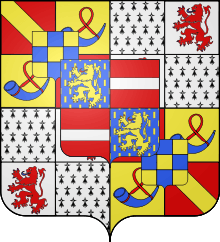René of Chalon
| René of Châlon, Prince of Orange | |
|---|---|
 René of Châlon | |
| Spouse(s) | Anna of Lorraine |
| Noble family | Châlon-Arlay and Nassau-Breda |
| Father | Henry III of Nassau-Breda |
| Mother | Claudia of Châlon |
| Born |
5 February 1519 Breda, Duchy of Brabant |
| Died |
15 July 1544 (aged 25) Saint-Dizier, Kingdom of France |
| Buried | Grote Kerk (Breda) |
René of Châlon (5 February 1519 – 15 July 1544), also known as Renatus of Châlon, was a Prince of Orange and stadtholder of Holland, Zeeland, Utrecht and Gelre.
Life
René was born in Breda, the only son of Count Henry III of Nassau-Breda and Claudia of Châlon. Claudia's brother, Philibert of Châlon, was the last Prince of Orange from the house of Châlon. When Philibert died in 1530, René inherited the Princedom of Orange on condition that he used the name and coat of arms of the Châlon-Orange family. History knows him therefore as René of Châlon instead of as "René of Nassau-Breda." [1]

René of Châlon married Anna of Lorraine (1522–1568) on 20 August 1540 at Bar-le-Duc. They had only one child, a daughter named Maria, who lived only 3 weeks and was buried in the Grote Kerk in Breda.
Death
In 1544, René took part in the siege of St. Dizier in the service of Emperor Charles V. He was mortally wounded in battle and died with the Emperor attending at his bedside.[3] René was buried in Grote Kerk in Breda, near the resting-place of his short-lived daughter. A commemorative cenotaph stands in the church of St. Etienne in Bar-le-Duc.
Succession
René of Châlon, as the last descendant of the original princes, left the principality to his first cousin William of Nassau-Dillenburg (better known as "William the Silent"), who was not a descendant of the original Orange family but became the legal heir to the principality of Orange, and all of René's lands. Thus, the principality which René had inherited from his mother was passed to his father's brother's son.
The principality of Orange had already passed, through the female line, from the first dynasty of Orange to the families Les Baux, and then to De Châlon.[4] It now passed to a family which was not descended in blood at all from any of the preceding families.
William added the name of Orange to his own paternal dignities and thus became in 1544 the founder of the House of Orange-Nassau.
Ancestors
| Ancestors of René of Chalon | ||||||||||||||||||||||||||||||||||||||||||||||||||||||||||||||||||||||||||||||||||||||||||||||||||||||||||||||||||||||||||||||||||||||||||||||||||||||||||||||||||||||||||||||||||||||||||||||||||||||||||||||||||||||||||||||||||||||||||||||||||||||||||||||||||||||||||||||||||||||||||||||||||||||||||||||||||||||||||||||||||||||||||||||||||||||||||||||||||||||||||||||||||||||||||||||||||||||||||||||||||||||||||||||||||||||||||||||||||||||||||||||||||||||||||||||||||||||||||||||||||||||||||||||||||||||||||||||||||
|---|---|---|---|---|---|---|---|---|---|---|---|---|---|---|---|---|---|---|---|---|---|---|---|---|---|---|---|---|---|---|---|---|---|---|---|---|---|---|---|---|---|---|---|---|---|---|---|---|---|---|---|---|---|---|---|---|---|---|---|---|---|---|---|---|---|---|---|---|---|---|---|---|---|---|---|---|---|---|---|---|---|---|---|---|---|---|---|---|---|---|---|---|---|---|---|---|---|---|---|---|---|---|---|---|---|---|---|---|---|---|---|---|---|---|---|---|---|---|---|---|---|---|---|---|---|---|---|---|---|---|---|---|---|---|---|---|---|---|---|---|---|---|---|---|---|---|---|---|---|---|---|---|---|---|---|---|---|---|---|---|---|---|---|---|---|---|---|---|---|---|---|---|---|---|---|---|---|---|---|---|---|---|---|---|---|---|---|---|---|---|---|---|---|---|---|---|---|---|---|---|---|---|---|---|---|---|---|---|---|---|---|---|---|---|---|---|---|---|---|---|---|---|---|---|---|---|---|---|---|---|---|---|---|---|---|---|---|---|---|---|---|---|---|---|---|---|---|---|---|---|---|---|---|---|---|---|---|---|---|---|---|---|---|---|---|---|---|---|---|---|---|---|---|---|---|---|---|---|---|---|---|---|---|---|---|---|---|---|---|---|---|---|---|---|---|---|---|---|---|---|---|---|---|---|---|---|---|---|---|---|---|---|---|---|---|---|---|---|---|---|---|---|---|---|---|---|---|---|---|---|---|---|---|---|---|---|---|---|---|---|---|---|---|---|---|---|---|---|---|---|---|---|---|---|---|---|---|---|---|---|---|---|---|---|---|---|---|---|---|---|---|---|---|---|---|---|---|---|---|---|---|---|---|---|---|---|---|---|---|---|---|---|---|---|---|---|---|---|---|---|---|---|---|---|---|---|---|---|---|---|---|---|---|---|---|---|---|---|---|---|---|---|---|---|---|---|---|---|---|---|---|---|---|---|---|---|---|---|---|---|---|---|---|---|---|---|---|---|---|---|---|---|---|---|---|---|---|---|---|---|---|---|---|---|---|---|---|---|---|---|---|---|---|---|---|---|---|---|---|---|---|---|---|---|---|---|---|---|---|---|---|---|---|---|---|---|---|---|---|---|---|---|---|---|---|---|---|---|---|---|---|---|---|---|
| ||||||||||||||||||||||||||||||||||||||||||||||||||||||||||||||||||||||||||||||||||||||||||||||||||||||||||||||||||||||||||||||||||||||||||||||||||||||||||||||||||||||||||||||||||||||||||||||||||||||||||||||||||||||||||||||||||||||||||||||||||||||||||||||||||||||||||||||||||||||||||||||||||||||||||||||||||||||||||||||||||||||||||||||||||||||||||||||||||||||||||||||||||||||||||||||||||||||||||||||||||||||||||||||||||||||||||||||||||||||||||||||||||||||||||||||||||||||||||||||||||||||||||||||||||||||||||||||||||
References
- ↑ Grew, Marion Ethel (1947). The House of Orange. 36 Essex Street, Strand, London W.C.2: Methuen & Co. Ltd.
- ↑ Rietstap, Johannes Baptist (2003). Armorial general. vol.2. Genealogical Publishing Co. p. 297. ISBN 0-8063-4811-9.
- ↑ Rowen, Herbert H. (1988). The princes of Orange: the stadholders in the Dutch Republic. Cambridge University Press. p. 11. ISBN 0-8063-4811-9.
- ↑ Motley, John Lothrop (1855). The Rise of the Dutch Republic. vol.1. Harper Brothers Publishers. p. 235.
| René of Chalon Born: 5 February 1519 Died: 15 July 1544 | ||
| Preceded by Philibert of Châlon |
Prince of Orange 1530–1544 |
Succeeded by William of Orange-Nassau |
| Preceded by Henry III of Nassau-Breda |
Baron of Breda 1538–1544 |
Succeeded by William of Orange-Nassau |
| Preceded by Antoine de Lalaing |
Stadtholder of Holland, Zeeland and Utrecht 1540–1544 |
Succeeded by Louis of Praet |
| Preceded by Floris van Egmont |
Stadtholder of Guelders 1543–1544 |
Succeeded by Philippe de Lalaing |